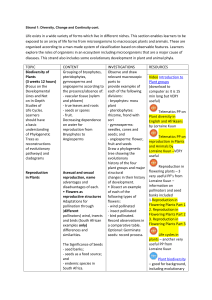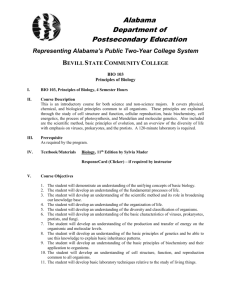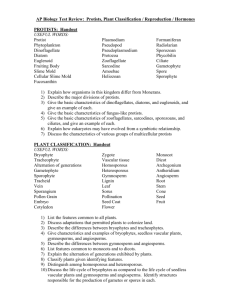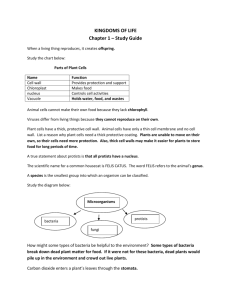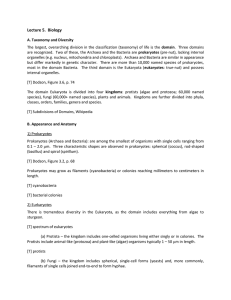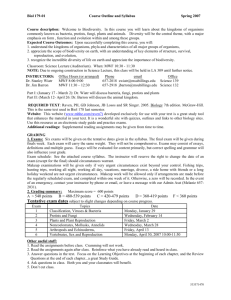Unit 6
advertisement
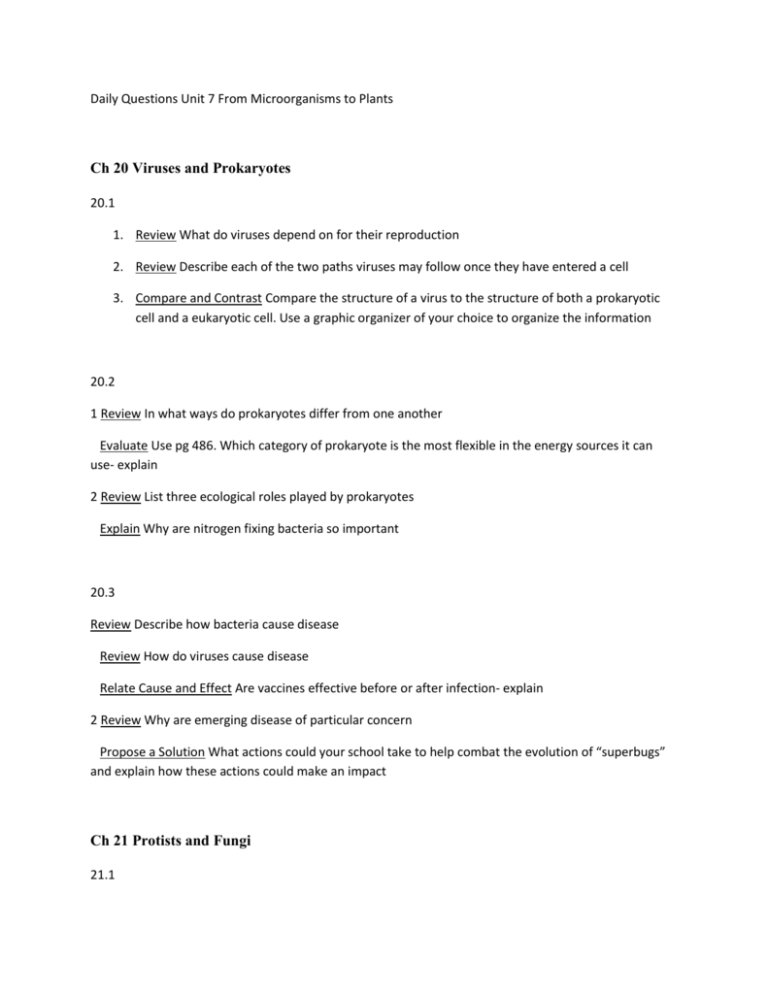
Daily Questions Unit 7 From Microorganisms to Plants Ch 20 Viruses and Prokaryotes 20.1 1. Review What do viruses depend on for their reproduction 2. Review Describe each of the two paths viruses may follow once they have entered a cell 3. Compare and Contrast Compare the structure of a virus to the structure of both a prokaryotic cell and a eukaryotic cell. Use a graphic organizer of your choice to organize the information 20.2 1 Review In what ways do prokaryotes differ from one another Evaluate Use pg 486. Which category of prokaryote is the most flexible in the energy sources it can use- explain 2 Review List three ecological roles played by prokaryotes Explain Why are nitrogen fixing bacteria so important 20.3 Review Describe how bacteria cause disease Review How do viruses cause disease Relate Cause and Effect Are vaccines effective before or after infection- explain 2 Review Why are emerging disease of particular concern Propose a Solution What actions could your school take to help combat the evolution of “superbugs” and explain how these actions could make an impact Ch 21 Protists and Fungi 21.1 1. Compare the diagram on pg 504 with the tree of life from chapter 18. What simplifications does this diagram make, how could this simplification be misinterpreted. Explain your answer using your knowledge from Ch 18 and of how cladograms are constructed 21.2 1. Explain How does conjugation produce genetic diversity in a population of Paramecium 2. Compare and Contrast How does a macronucleus differ in function from a micronucleus 3. Compare and Contrast Compare asexual and sexual processes in paramecium- include the terms mitosis and meiosis 21.3 1 Review Give three examples of photosynthetic protists Predict How would ocean food chains change in the absence of photosynthetic protists 2 Explain By what two methods do parasitic protists primarily spread disease Form an Opinion Why are protist caused disease more widespread in tropical areas of the world. 21.4 1. Both bacteria and fungi are decomposers. What characteristics do these two groups share that allow them to function in this ecological role- you may want to use information from 21.2 Ch 22 Introduction to Plants 22.1 1. Calculate What percent of all plants are flowering plants 2. Interpret Graphs What is the second largest group of plants 3. Pose Questions What question about plant evolution would you ask based on the data in this graph Graph also on pg 530. 22.3 1. Apply Concepts Pollination is a process that occurs only in seed plants. What process in seedless plants is analogous to pollination 2. Review Describe how fertilization takes place in a gymnosperm 3. Classify Make a table with two columns labeled haploid and diploid and assign each of the following structures from the pine life cycle to the appropriate column: Pollen tube, Seed cone, Embryo, Ovule, Seedling 22.4 1. Form a Hypothesis Which are more likely to be dispersed by animals- the seeds of an angiosperm or a gymnosperm- explain 2. Explain How do the three methods of categorization differ from scientific methods 3. Form an Opinion Is it useful or misleading to categorize angiosperms in ways that do not reflect evolutionary relationships- defend your opinion Ch 23 Plant Structure and Function 23.1 1. Review What are the three main tissue systems of plants 2. Compare and Contrast How do the three main functions of a plant’s tissue differ 3. Form and Function How might the presence of meristems explain the ability of plants to regenerate from cuttings 4. Infer With your prior knowledge of the circulatory system, write a paragraph comparing and contrasting the structure and function of the vascular system of a plant to the human circulatory system 23.2 1. Review How are tissues distributed in plant roots 2. Apply Concepts Why is it important that the root endodermis permits only a one way passage of materials 3. Classify Draw and label a diagram to show how roots absorb water and nutrients- also include a brief description 23.3 1 Review What are three important functions of stems Explain How does the arrangement of vascular bundles in monocot stems differ from dicot stems Apply Concepts How do the functions of a stem relate to the functions of the roots and leaves of a plant 2 Review Define primary and secondary growth Predict Describe what would happen over time to a tree sapling that could grow only taller, not wider 23.5 1. Review What two forces are responsible for 90% of the upward flow of water through a plant 2. Review What is the hypothesis that explains the movement of fluid through phloem of a plant 3. Infer Explain how movement of sugars in phloem contributes to homeostasis in a plant. Ch 24 Plant Reproduction and Response 24.1 1. Classify Which plant structures are male sexual organs and which are female sexual organs 2. Apply Concepts Relate the characteristics of angiosperms reproduction to angiosperm success 3. Review Define vegetative reproduction 4. Compare and Contrast Make a compare contrast table comparing alternation of generations in flowering plants and green algae (22.2) 24.2 1 Explain Why is it adaptive for some seeds to remain dormant before they germinate Apply Concepts The seeds of a bishop pine germinate only after exposure to the extreme heat of a forest fire. Evaluate the significance of this structural adaptation 2 Pose a Question A new angiosperm species is discovered. What questions would you ask before predicting how its seeds are dispersed- explain why you would ask each. 24.3 1 Apply Concepts Using a houseplant, a marker and a sunny windowsill, describe how you might measure the plant’s response to light 2 Review Summarize plant responses to seasonal changes 3 Explain Which type of plant- short or long day- is likely to bloom in the summer- explain Design an Experiment Design a controlled experiment to find out how a garden store owner could determine what light conditions are needed for a particular flowering plant to bloom 24.4 1. Relate Cause and Effect Describe how selective breeding was used to develop corn from an ancestral grass that looked very different 2. Infer What effect could plant species extinction have on therapeutic drug development

